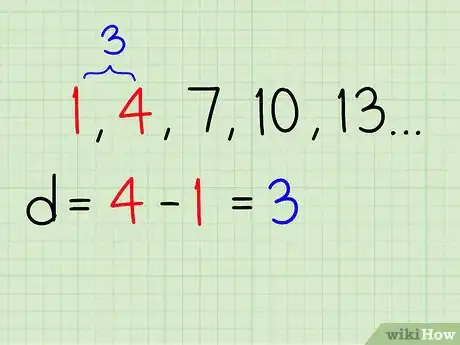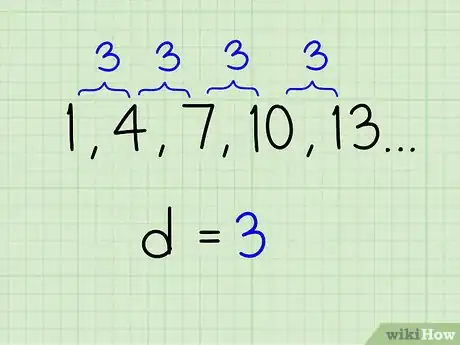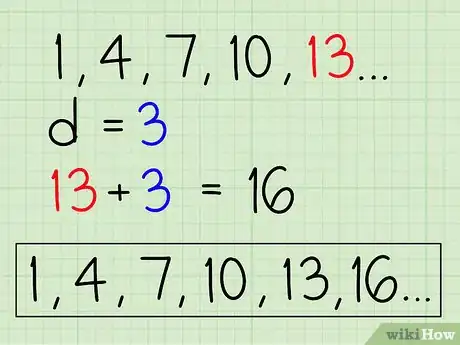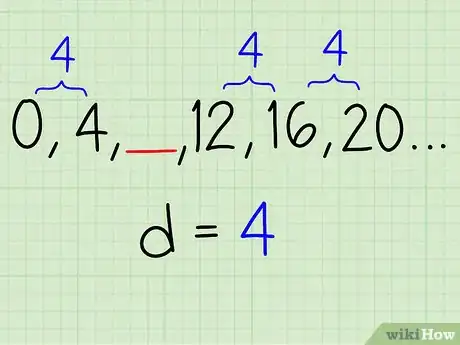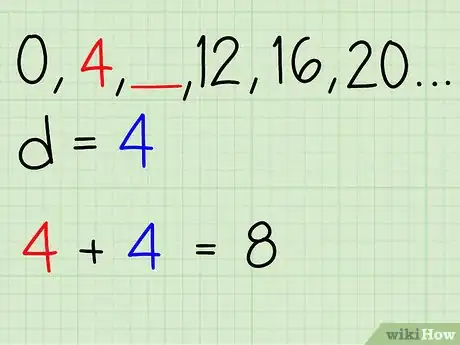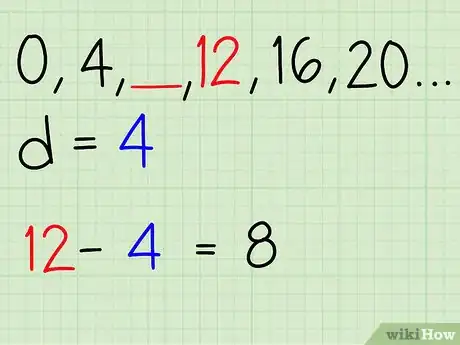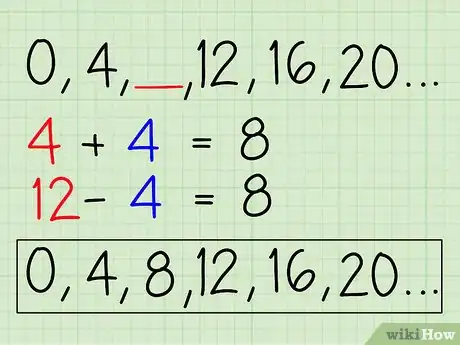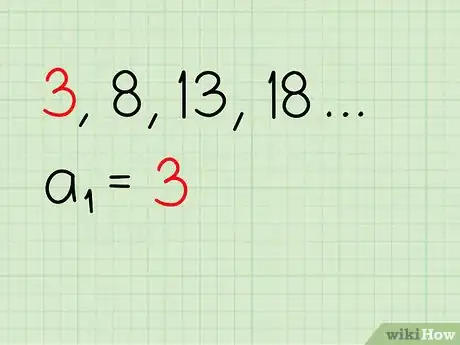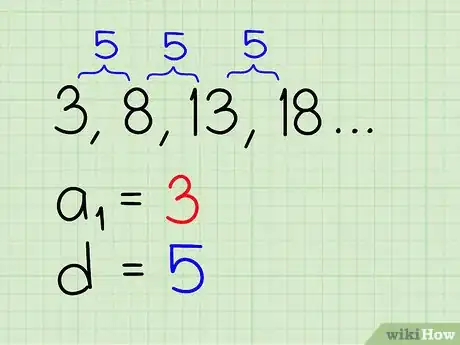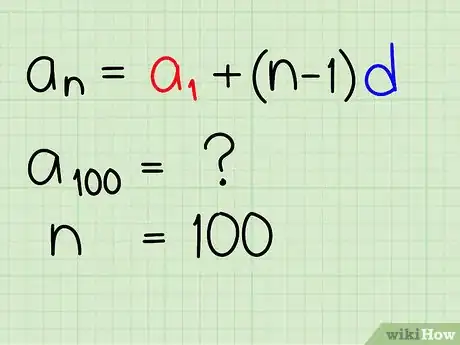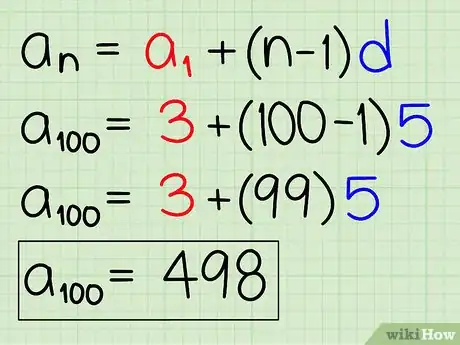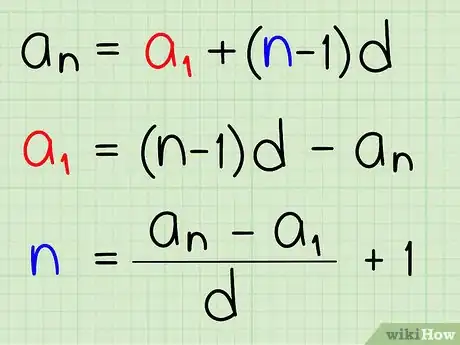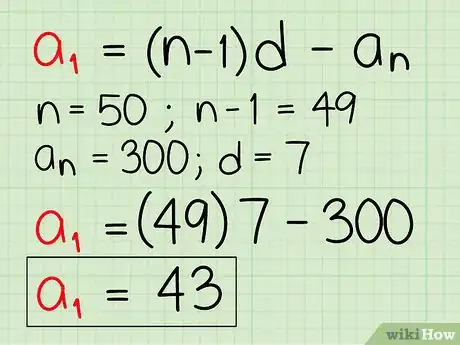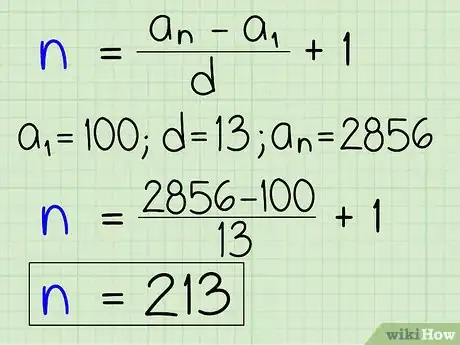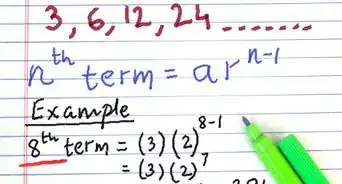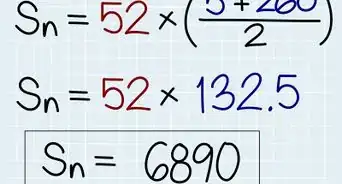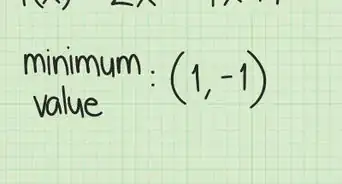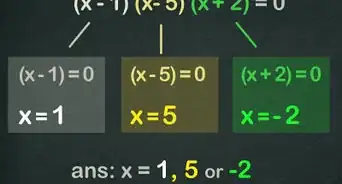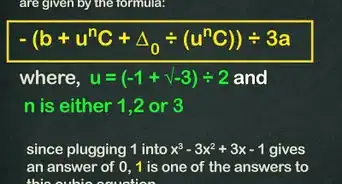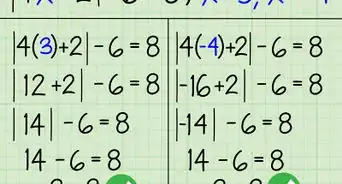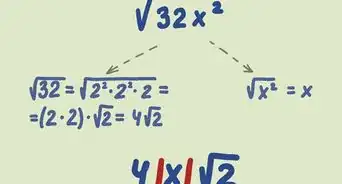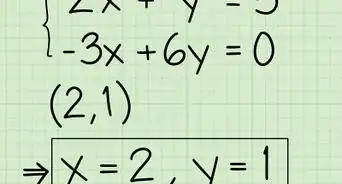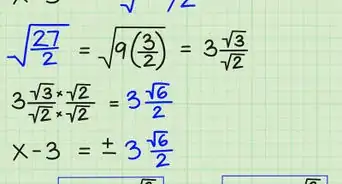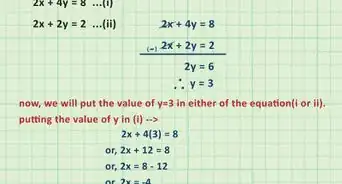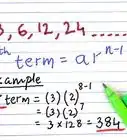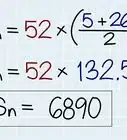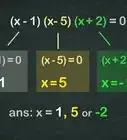This article was co-authored by wikiHow Staff. Our trained team of editors and researchers validate articles for accuracy and comprehensiveness. wikiHow's Content Management Team carefully monitors the work from our editorial staff to ensure that each article is backed by trusted research and meets our high quality standards.
There are 10 references cited in this article, which can be found at the bottom of the page.
This article has been viewed 337,062 times.
Learn more...
An arithmetic sequence is any list of numbers that differ, from one to the next, by a constant amount. For example, the list of even numbers, … is an arithmetic sequence, because the difference from one number in the list to the next is always 2.[1] If you know you are working with an arithmetic sequence, you may be asked to find the very next term from a given list. You may also be asked to fill in a gap where a term is missing. Finally, you might want to know, for example, the 100th term, without actually writing out all 100 terms. A few simple steps can help you do any of these.
Steps
Finding the Next Term in an Arithmetic Sequence
-
1Find the common difference for the sequence. When you are presented with a list of numbers, you may be told that the list is an arithmetic sequence, or you may need to figure that out for yourself. The first step is the same in either case. Select the first two consecutive terms in the list. Subtract the first term from the second term. The result is the common difference of your sequence.[2]
- For example, suppose you have the list .... Subtract to find the common difference of 3.
- Suppose you have a list of terms that decreases, such as …. You still subtract the first term from the second to find the difference. In this case, that gives you . The negative result means that your list is decreasing as you read from left to right. You should always check that the sign of the difference matches the direction that the numbers seem to be going.
-
2Check that the common difference is consistent. Finding the common difference for just the first two terms does not ensure that your list is an arithmetic sequence. You need to make sure that the difference is consistent for the whole list.[3] Check the difference by subtracting two different consecutive terms in the list. If the result is consistent for one or two other pairs of terms, then you probably have an arithmetic sequence.
- Working with the same example, … choose the second and third terms of the list. Subtract , and you find that the difference is still 3. To confirm, check one more example and subtract , and you find that the difference is consistently 3. You can be pretty sure that you are working with an arithmetic sequence.
- It is possible for a list of numbers to appear to be an arithmetic sequence based on the first few terms, but then fail after that. For example, consider the list …. The difference between the first and second terms is 1, and the difference between the second and third terms is also 1. However, the difference between the third and fourth terms is 3. Because the difference is not common for the entire list, then this is not an arithmetic sequence.
Advertisement -
3Add the common difference to the last given term. Finding the next term of an arithmetic sequence after you know the common difference is easy. Simply add the common difference to the last term of the list, and you will get the next number.[4]
- For example, in the example of …, to find the next number in the list, add the common difference of 3 to the last given term. Adding results in 16, which is the next term. You can continue adding 3 to make your list as long as you like. For example, the list would be …. You can do this as long as you like.
Finding a Missing Internal Term
-
1Verify that you are starting with an arithmetic sequence. In some cases, you may have a list of numbers with a missing term in the middle. Begin, as before, by checking that your list is an arithmetic sequence. Select any two consecutive terms and find the difference between them. Then check this against two other consecutive terms in the list. If the differences are the same, you can presume that you are working with an arithmetic sequence and proceed.
- For example, suppose you have the list ,___,…. Start by subtracting to find a difference of 4. Check this against two other consecutive terms, such as . The difference is again 4. You can proceed.
-
2Add the common difference to the term before the space. This is similar to adding a term to the end of a sequence. Find the term that immediately precedes the space in your sequence. This is the “last” number that you know. Add your common difference to this term, to find the number that should fill in the space.[5]
- In our working example, ,____,…, the term preceding the space is 4, and our common difference for this list is also 4. So add to get 8, which should be the number in the blank space.
-
3Subtract the common difference from the term following the space. To be sure that you have the correct answer, check from the other direction. An arithmetic sequence should be consistent going in either direction. If you move from left to right and add 4, then going in the opposite direction, from right to left, you would do the opposite and subtract 4.[6]
- In the working example, ,___,…, the term immediately following the space is 12. Subtract the common difference of 4 from this term to find . The result of 8 should fill in the blank space.
-
4Compare your results. The two results that you get, from adding up from the bottom or from subtracting down from the top should match. If they do, then you have found the value for the missing term. If they do not, then you need to check your work. You may not have a true arithmetic sequence.
- In the working example, the two results of and both gave the solution of 8. Therefore, the missing term in this arithmetic sequence is 8. The full sequence is ….
Finding the Nth Term of an Arithmetic Sequence
-
1Identify the first term of the sequence. Not every sequence begins with the numbers 0 or 1. Look at the list of numbers that you have and find the first term. This is your starting point, which can be designated using variables as a(1).
- It is common in working with arithmetic sequences to use the variable a(1) to designate the first term of a sequence. You may, of course, choose any variable you like, and the results should be the same.
- For example, given the sequence …, the first term is , which can be designated algebraically as a(1).
-
2Define your common difference as d. Find the common difference for the sequence as before. In this working example, the common difference is , which is 5. Checking with other terms in the sequence provides the same result. We will note this common difference with the algebraic variable d.[7]
-
3Use the explicit formula. An explicit formula is an algebraic equation that you can use to find any term of an arithmetic sequence, without having to write out the full list. The explicit formula for an algebraic sequence is .[8]
- The term a(n) can be read as “the nth term of a,” where n represents which number in the list you want to find and a(n) is the actual value of that number. For example, if you are asked to find the 100th item in an arithmetic sequence, then n will be 100. Note that n is 100, in this example, but a(n) will be the value of the 100th term, not the number 100 itself.
-
4Fill in your information to solve the problem. Using the explicit formula for your sequence, fill in the information that you know to find the term that you need.[9]
- For example, in the working example …, we know that a(1) is the first term 3, and the common difference d is 5. Suppose you are asked to find the 100th term in that sequence. Then n=100, and (n-1)=99. The complete explicit formula, with the data filled in, is then . This simplifies to 498, which is the 100th term of that sequence.
Using the Explicit Formula to Find Additional Information
-
1Rearrange the explicit formula to solve for other variables. Using the explicit formula[10] and some basic algebra, you can find several pieces of information about an arithmetic sequence. In its original form, , the explicit formula is designed to solve for an and give you the nth term of a sequence. However, you can algebraically manipulate this formula and solve for any of the variables.
- For example, suppose you have the end of a list of numbers, but you need to know what the beginning of the sequence was. You can rearrange the formula to give you
- If you know the starting point of an arithmetic sequence and its ending point, but you need to know how many terms are in the list, you can rearrange the explicit formula to solve for n. This would be .
- If you need to review the basic rules of algebra to create this result, check out Learn Algebra or Simplify Algebraic Expressions.
-
2Find the first term of a sequence. You may know that the 50th term of an arithmetic sequence is 300, and you know that the terms have been increasing by 7 (the “common difference”), but you want to find out what the first term of the sequence was. Use the revised explicit formula that solves for a1 to find your answer.[11]
- Use the equation , and fill in the information that you know. Since you know that the 50th term is 300, then n=50, n-1=49 and a(n)=300. You also are given that the common difference, d, is 7. Therefore, the formula becomes . This works out to . The sequence that you have began at 43, and counted up by 7. Therefore, it looks like 43,50,57,64,71,78…293,300.
-
3Find the length of a sequence. Suppose you know all about the start and end of an arithmetic sequence, but you need to find out how long it is. Use the revised formula .[12]
- Suppose you know that a given arithmetic sequence begins at 100 and increases by 13. You are also told that the final term is 2,856. To find the length of the sequence, use the terms a1=100, d=13, and a(n)=2856. Insert these terms into the formula to give . If you work this out, you get , which equals 212+1, which is 213. There are 213 terms in that sequence.
- This sample sequence would look like 100, 113, 126, 139… 2843, 2856.
Community Q&A
-
QuestionGiven only the 10th and 15th term, how do I find the first three terms?
 DonaganTop AnswererSubtract the 10th term from the 15th term and divide by 5: that gives you D, the difference between any two consecutive terms. Multiply D by 9, and subtract that amount from the 10th term; that gives you the first term.
DonaganTop AnswererSubtract the 10th term from the 15th term and divide by 5: that gives you D, the difference between any two consecutive terms. Multiply D by 9, and subtract that amount from the 10th term; that gives you the first term. -
QuestionWhat is the formula for the sequence 8,16,32,64,___?
 DonaganTop AnswererThis is not an arithmetic sequence. Look up geometric sequences for whatever formula you're interested in.
DonaganTop AnswererThis is not an arithmetic sequence. Look up geometric sequences for whatever formula you're interested in. -
QuestionHow do I calculate the 5 terms of an arithmetic sequence if the first term is 8 and the last term is 100?
 DonaganTop AnswererSubtract 8 from 100 = 92. Divide 92 by 4 (because with five terms there will be four intervals between the first and last term). That gives you 23, the size of each interval. So the sequence begins with 8 and has a common difference of 23.
DonaganTop AnswererSubtract 8 from 100 = 92. Divide 92 by 4 (because with five terms there will be four intervals between the first and last term). That gives you 23, the size of each interval. So the sequence begins with 8 and has a common difference of 23.
Warnings
- There are different kinds of sequences of numbers. Do not assume that a list of numbers is an arithmetic sequence. Always check at least two pairs of terms, or preferably three or four, to find the common difference between terms.⧼thumbs_response⧽
References
- ↑ https://www.mathsisfun.com/algebra/sequences-sums-arithmetic.html
- ↑ https://www.alamo.edu/contentassets/afe30946fa58450c89840c1173f3b9d0/sequences/math1314-arithmetic-sequences.pdf
- ↑ https://www.varsitytutors.com/hotmath/hotmath_help/topics/common-difference
- ↑ https://www.alamo.edu/contentassets/afe30946fa58450c89840c1173f3b9d0/sequences/math1314-arithmetic-sequences.pdf
- ↑ http://virtualnerd.com/middle-math/number-algebraic-sense/sequences-patterns/missing-term-sequence-example
- ↑ https://virtualnerd.com/middle-math/number-algebraic-sense/sequences-patterns/missing-term-sequence-example
- ↑ https://virtualnerd.com/algebra-2/sequences-series/arithmetic/arithmetic-sequences/sequence-nth-term-example
- ↑ https://www.cuemath.com/questions/how-to-find-the-nth-term-of-an-arithmetic-sequence/
- ↑ https://www.cuemath.com/questions/how-to-find-the-nth-term-of-an-arithmetic-sequence/
- ↑ https://mathbitsnotebook.com/Algebra1/Functions/FNSequenceFunctions.html
- ↑ https://www.khanacademy.org/math/algebra/x2f8bb11595b61c86:sequences/x2f8bb11595b61c86:constructing-arithmetic-sequences/a/writing-explicit-formulas-for-arithmetic-sequences
- ↑ https://www.cuemath.com/arithmetic-sequence-explicit-formula/
About This Article
To find a term in an arithmetic sequence, determine the common difference by subtracting the first number from the second number. Then, confirm that the difference is consistent between each number in the sequence by repeating the above equation with the second and third numbers, the third and fourth numbers, and so on. Once you’ve confirmed the common difference, all you have to do to find the missing number is add the common difference to preceding term in the sequence. If you want to learn how to find a term later on in a sequence of numbers, keep reading the article!

